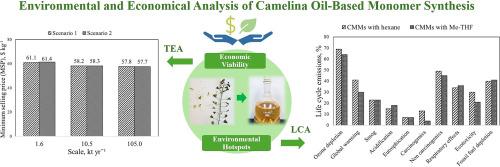Early process design approaches for environmentally sustainable and cost-effective Camelina oil-based acrylic monomers production
IF 9.2
2区 工程技术
Q1 ENERGY & FUELS
引用次数: 0
Abstract
We integrated life cycle assessment (LCA) and techno-economic analysis (TEA) in the initial phases of camelina oil-based acrylic monomers (CMMs) production, aiming to comprehensively evaluate their environmental performance and cost efficiency. The biogenic CO2 sequestration associated with camelina cultivation played a key role in reducing the overall greenhouse gas (GHG) emissions resulting from CMM's production. Results showed that replacing dichloromethane with greener solvents alternatives, such as 2-methyltetrahydrofurane (Me-THF) and hexane, adressed not only environmental, health, and safety concerns but also improved yields by up to 9 %. The study also indicated the significance of recycling alternative solvents, demonstrating significant reductions in the environmental impacts, particularly in ozone and fossil fuel depletion categories. Despite variations in scenarios using alternative solvents, the minimum selling price (MSP) remained steady at approximately $61 per kg, maintaining competitiveness with petroleum-based alternative while offering a lower environmental footprint. The MSPs were primarily influenced by fluctuations in raw material prices and total capital investments, with only a moderate reductions observed as production scales up from 1.6 to 105 kton per year. Notably, this study demonstrated the viability of biobased monomers as alternatives to petroleum-based butyl acrylate, with a 23 % reduction in GHG emissions attributed to CO₂ sequestration during camelina cultivation. Additionally, solvents recycling significantly reduced most environmental impacts, achieving a 70 % and 12 % decrease in ozone depletion and fossil fuel depletion categories, respectively. Overall, these findings provide valuable insights for decision-making in the early design stages of the biobased acrylic monomers, emphasizing their potential for sustainable polymer development.

环境可持续和成本效益的亚麻油基丙烯酸单体生产的早期工艺设计方法
本文将生命周期评价(LCA)与技术经济分析(TEA)相结合,对亚麻油基丙烯酸单体(cmm)生产的初始阶段进行了综合评价,旨在对其环境性能和成本效益进行综合评价。与亚麻荠种植相关的生物源性CO2固存在减少亚麻荠生产产生的温室气体排放总量中发挥了关键作用。结果表明,用更环保的溶剂替代二氯甲烷,如2-甲基四氢呋喃(Me-THF)和己烷,不仅解决了环境、健康和安全问题,而且产量提高了9%。这项研究还指出了回收替代溶剂的重要性,表明大大减少了对环境的影响,特别是在臭氧和矿物燃料耗竭类别方面。尽管使用替代溶剂的情况有所不同,但最低销售价格(MSP)保持稳定在每公斤61美元左右,与石油基替代品保持竞争力,同时提供更低的环境足迹。最低供应量主要受到原材料价格波动和资本投资总额的影响,随着产量从每年1.6千吨增加到105千吨,只有适度减少。值得注意的是,这项研究证明了生物基单体作为石油基丙烯酸丁酯的替代品的可行性,在亚麻荠种植过程中由于二氧化碳的封存,温室气体排放量减少了23%。此外,溶剂回收显著减少了大多数环境影响,臭氧消耗和化石燃料消耗分别减少了70%和12%。总的来说,这些发现为生物基丙烯酸单体的早期设计阶段的决策提供了有价值的见解,强调了它们在可持续聚合物发展中的潜力。
本文章由计算机程序翻译,如有差异,请以英文原文为准。
求助全文
约1分钟内获得全文
求助全文
来源期刊

Sustainable Materials and Technologies
Energy-Renewable Energy, Sustainability and the Environment
CiteScore
13.40
自引率
4.20%
发文量
158
审稿时长
45 days
期刊介绍:
Sustainable Materials and Technologies (SM&T), an international, cross-disciplinary, fully open access journal published by Elsevier, focuses on original full-length research articles and reviews. It covers applied or fundamental science of nano-, micro-, meso-, and macro-scale aspects of materials and technologies for sustainable development. SM&T gives special attention to contributions that bridge the knowledge gap between materials and system designs.
 求助内容:
求助内容: 应助结果提醒方式:
应助结果提醒方式:


